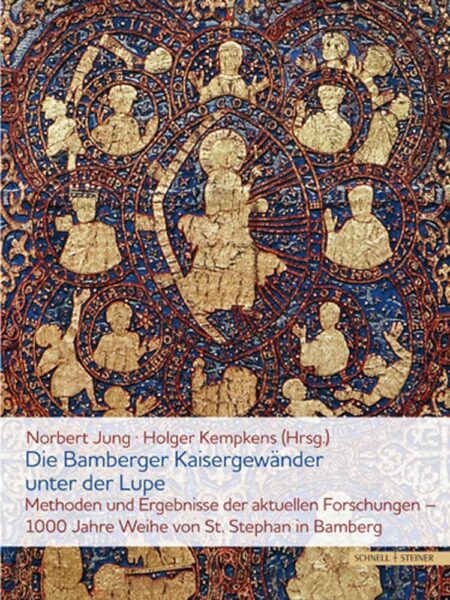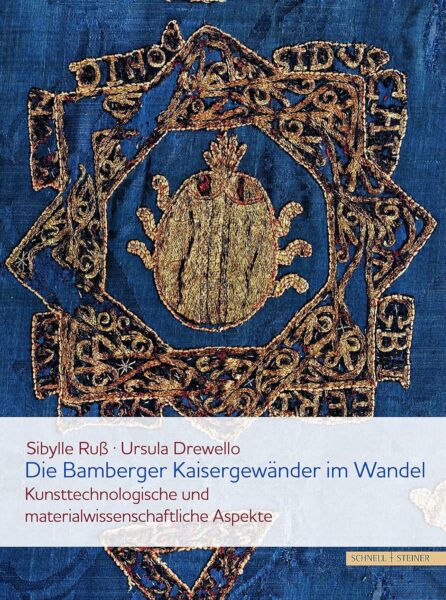Two new books explore in detail the precious and unique imperial garments preserved in Bamberg Cathedral’s treasury
In 2015, a group of textile researchers received a grant to study the Imperial Clothes preserved as relics of the sainted couple of Henry II (973–1024) and Cunigunde (975-1033) for more than a thousand years in the treasury at the Bamberg Cathedral. Recently, the results have been published.
 It goes without saying that the precious relics from the High Middle Agesin Bamberg have not survived without suffering numerous alterations, reworkings and plain old-fashioned vandalism. For instance, Cunigunde’s so-called tunic was used as a helper for birthing women in the later Middle Ages. This led to a reworking intended to make it possible for the birth mother to squeeze herself into the garment.
It goes without saying that the precious relics from the High Middle Agesin Bamberg have not survived without suffering numerous alterations, reworkings and plain old-fashioned vandalism. For instance, Cunigunde’s so-called tunic was used as a helper for birthing women in the later Middle Ages. This led to a reworking intended to make it possible for the birth mother to squeeze herself into the garment.
Nevertheless, the garments offer a unique opportunity to see and grasp the more luxurious textiles a royal couple might wear during their public “performances”. For instance, it does not take much imagination to see the royal couple wrapped in their magnificent capes sitting in a royal pew in the Cathedral in Bamberg witnessing the celebration of mass during the easter celebrations in Bamberg in AD 1020, when the so-called Sternen-Mantel (Star Mantel) was gifted to the Emperor by Ishmael of Bari.
The results of the laborious studies of the six items in the collection have diligently been published in two volumes.
 The first one came out in 2021 and described the present condition of the tunics and capes as well as the different approaches available to the textile researcher – art historical, technological, and material – as well as the history of the events in 1020 and later, when the imperial cathedral, St. Stephen, was consecrated in the presence of the Holy Roman Emperor, the Queen Cunigunde, and the visiting Pope, Benedict VIII (c. 980 – 1024).
The first one came out in 2021 and described the present condition of the tunics and capes as well as the different approaches available to the textile researcher – art historical, technological, and material – as well as the history of the events in 1020 and later, when the imperial cathedral, St. Stephen, was consecrated in the presence of the Holy Roman Emperor, the Queen Cunigunde, and the visiting Pope, Benedict VIII (c. 980 – 1024).
Recently, the second volume was published focusing in detail on the art history, the technology, and the material involved in the original remains as well as the innumerable reworkings carried out over time.
The books are priceless for sorting out the layers upon layers of details involved in separating the wheat from the chaff. Unfortunately, diligent studies reveal how little of the original garments have been preserved. To be precise, the ornaments are what is left, and in some cases not even the original fabric on which they were fastened can be identified.
Nevertheless, a visit to the Cathedral and the treasury is highly recommended. Not least in the autumn of 2024, when Bamberg invites us to visit an exhibition focusing on the daily life at the court of the royal couple in the first half of the eleventh century.
NAMES:
Henry II, King of Germany and Italy, and Holy Roman Emperor 1002–1024 – Heinrich II.
Cunigunde c. 975 –1033 – Kunigunde.
FEATURED PHOTO:
Detail from the Blue Mantel of Cunigunde showing a king. The researchers believe the king’s portrait was changed from a Byzantine Emperor to that of Henry II © Schousboe
SOURCES:
Die Bamberger Kaisergewander Im Wandel: Kunsttechnologische Und Materialwissenschaftliche Aspekte
By Ursula Drewello and Sibylle Russ
Schnell & Steiner 2023
Die Bamberger Kaisergewander Unter Der Lupe. Methoden Und Ergebnisse Der Aktuellen Forschungen: 1000 Jahre Weihe Von St. Stephan in Bamberg
Ed. by Holger Kempkens and Norbert Jung
Schnell & Steiner 2021
READ ALSO:
